A new class of small molecule drugs, now in phase 1 clinical trials, is the first to target circadian clock proteins, which play a key role in the recurrence and spread of the deadly cancer.
By Zara Abrams

A new type of small molecule drug, the first to target circadian clock proteins as a way to treat glioblastoma, is now in phase 1 clinical trials. (Image Issey Takahashi)
Glioblastoma, the most common cancerous brain tumor in adults, is an aggressive disease—patients survive an average of just 15 months once they are diagnosed. Despite more than two decades of research on the causes and treatments of glioblastoma, that prognosis has hardly improved.
But recent work by a Keck School of Medicine of USC-led team has demonstrated that circadian clock proteins, which help coordinate changes in the body’s functions over the course of a day, may play a key role in glioblastoma growth and proliferation after current standard treatments. This discovery has led to a potential breakthrough: the identification of a small molecule drug, known as SHP656, that can target the clock proteins and may prove effective for treating the disease.

Steve Kay, PhD, University and Provost Professor of neurology, biomedical engineering and biological sciences at the Keck School of Medicine of USC and director of the USC Michelson Center for Convergent Bioscience
“This is a potent molecule that’s very exciting to us in terms of its potential for deployment against glioblastoma,” said Steve Kay, PhD, University and Provost Professor of neurology, biomedical engineering and biological sciences at the Keck School of Medicine of USC and director of the USC Michelson Center for Convergent Bioscience.
Kay assembled a collaborative that unites academics with expertise in glioblastoma, circadian clock biology and biological chemistry with Synchronicity Pharma, a biotechnology startup that he co-founded. Results of their research on the SHP656 molecule, were just published in Proceedings of the National Academy of Sciences.
“We’re now starting to march down the path of clinical drug development—turning this from a science story into a translational one,” said Kay, the study’s senior author, who also co-directs the Rosalie and Harold Rae Brown Center for Cancer Drug Development at the USC Norris Comprehensive Cancer Center.
Neutralizing rogue cells
The first symptoms of glioblastoma can include everything from blurred vision, headaches and nausea to seizures and personality changes. Patients typically undergo a brain scan, which identifies the tumor, then receive a combination of surgery, radiation and chemotherapy treatment. While most tumors shrink substantially after the initial treatment, few patients experience sustained remission.
“In the vast majority of patients, the cancer returns. And when it returns, it’s resistant to chemotherapy and radiation,” Kay said.
Researchers believe that the cancer returns because a small number of “cancer stem cells” are left behind after surgery, chemotherapy and radiation. These stem cells can multiply and spread very quickly—and research by Kay’s team helps explain why. He and Jeremy N. Rich, MD, of the University of Pittsburgh, found that cancer stem cells hijack the body’s circadian clock machinery, allowing them to spread more quickly and resist the effects of chemotherapy and radiation treatment.
Armed with that knowledge, Kay and his collaborators created and tested thousands of molecules capable of binding to—and potentially neutralizing—the rogue circadian clock proteins inside cancer stem cells. They used several advanced techniques, including artificial intelligence (AI), to determine which molecule was best suited to fight glioblastoma. The team’s AI algorithms modeled how each new molecule would bind to the clock proteins, searching for the perfect “lock-and-key” fit. They pinpointed one particularly promising molecule: SHP656.
The next step was to test the effectiveness of SHP656 against actual cancer cells. Using glioblastoma stem cells collected from patients, the researchers showed that SHP656 reduced the growth of cancer stem cells, but did not harm the body’s normal stem cells.
“We’re seeing that the molecule acts differently on healthy brain cells versus tumor cells,” Kay said. “This was a real leap forward in our understanding of how we can develop drugs that target clock proteins.”
Expanding potential
Synchronicity Pharma has now begun phase 1 clinical trials for this class of new molecules. So far, the molecule appears to be safe in healthy volunteers. They hope to begin phase 2 trials in glioblastoma patients within two to three years.
In addition to its potential for treating glioblastoma, SHP656 and other molecules that target clock proteins hold promise for treating other types of cancer. Kay and his colleagues are also studying their utility in colorectal cancer, liver cancer and acute myeloid leukemia.
“This study shows that when you bring together the right kind of collaborative, academic researchers can be leaders in the discovery of cancer drugs,” he said.
About this study
In addition to Kay, the study’s other authors are Priscilla Chan from the Department of Biomedical and Biological Sciences, Keck School of Medicine of USC; Tsuyoshi Hirota, Simon Miller, Manish Kesherwani, Yoshiko Nagai, Moeri Yagi and Florence Tama from the Institute of Transformative Bio-Molecules, Nagoya University; and Jamie Cope from Synchronicity Pharma LLC.
This work was supported by the Japan Society for the Promotion of Science Grants [18H02402, 20K21269, 21H04766]; the Takeda Science Foundation; the Uehara Memorial Foundation; the Tokyo Biochemical Research Foundation; the Hitachi Global Foundation; the Rosalie and Harold Rae Brown Center for Cancer Drug Development at the USC Norris Comprehensive Cancer Center; Synchronicity Pharma LLC; the National Cancer Institute [R01CA238662-01]; the National Institute of Neurological Disorders and Stroke [1F31NS120654-01]; and the Charlie Teo Foundation-More Data Better Tools grant.
Disclosure: Steve Kay serves on the board of Synchronicity Pharma LLC and receives financial compensation for his role.